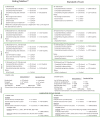High School Follow-Up of the Dating Matters® RCT: Effects on Teen Dating Violence and Relationship Behaviors
- PMID: 38459353
- PMCID: PMC11111327
- DOI: 10.1007/s11121-024-01648-z
High School Follow-Up of the Dating Matters® RCT: Effects on Teen Dating Violence and Relationship Behaviors
Erratum in
-
Correction: High School Follow-Up of the Dating Matters® RCT: Effects on Teen Dating Violence and Relationship Behaviors.Prev Sci. 2024 Jul;25(5):861. doi: 10.1007/s11121-024-01691-w. Prev Sci. 2024. PMID: 38805164 Free PMC article. No abstract available.
Abstract
Teen dating violence (TDV) is a significant public health problem that can have lifelong consequences. Using a longitudinal, cluster randomized controlled trial (RCT), this study examines whether the Dating Matters comprehensive prevention model, implemented in middle school, prevented TDV and negative relationship behaviors and promoted positive relationship behaviors in high school (9th-11th grades), when compared with a standard of care intervention. Dating Matters includes programs for sixth to eighth grade youth and their parents, training for school staff, a youth communications program, and policy and data activities implemented in the community. Self-report survey data were collected from students in 46 middle schools that were randomly assigned to condition within site. Students completed two surveys (fall and spring) in each middle school grade and a single survey in the spring of each high school grade. This study examined self-reported TDV perpetration and victimization, use of negative conflict resolution strategies, and positive relationship skills in the high school follow-up. While varying patterns emerged, latent panel models demonstrated significant program effects for all outcomes. Dating Matters students reported 19% reduced risk for TDV perpetration, 24% reduced risk for TDV victimization, 7% reduced risk for use of negative conflict strategies, and 3% more use of positive relationship skills, on average across time and cohort, than standard of care students. On average, Dating Matters, implemented in middle school, continued to be more effective at reducing TDV perpetration, TDV victimization, and use of negative conflict resolution strategies in high school than an evidence-based comparison program.Trial Registration: clinicaltrials.gov Identifier: NCT01672541.
Keywords: Intervention research; Relationship skills; Teen dating violence.
© 2024. This is a U.S. Government work and not under copyright protection in the US; foreign copyright protection may apply.
Conflict of interest statement
None of the authors have conflicts of interest or financial disclosures. All CDC authors worked for the funding organization during the majority of their participation on the project. Dr. Taylor was funded by CDC through a contract to assist with research design and collect all data (Contract #200-211-40998. Statisticians were funded through a staffing contract (Tracy) and IPAs (Little, Bontempo).
Figures






References
-
- Basile, K. C., Clayton, H. B., DeGue, S., Gilford, J. W., Vagi, K. J., Suarez, N. A., . . . Lowry, R. (2020). Interpersonal violence victimization among high school students—Youth risk behavior survey, United States, 2019. MMWR supplements, 69(1), 28. Retrieved from https://www.ncbi.nlm.nih.gov/pmc/articles/PMC7440202/pdf/su6901a4.pdf - PMC - PubMed
-
- Breiding, M. J., Basile, K. C., Smith, S. G., Black, M. C., & Mahendra, R. R. (2015). Intimate partner violence surveillance: Uniform definitions and recommended data elements, Version 2.0. In. Atlanta, GA: National Center for Injury Prevention and Control, Centers for Disease Control and Prevention
-
- De La Rue L, Polanin JR, Espelage DL, Pigott TD. A meta-analysis of school-based interventions aimed to prevent or reduce violence in teen dating relationships. Review of Educational Research. 2017;87(1):7–34. doi: 10.3102/0034654316632061. - DOI
-
- DeGue, S., Niolon, P. H., Estefan, L. F., Tracy, A. J., Le, V. D., Vivolo-Kantor, A. M., . . . Lang, K. M. (2021). Effects of Dating Matters® on sexual violence and sexual harassment outcomes among middle school youth: A cluster-randomized controlled trial. Prevention science, 22(2), 175–185. - PMC - PubMed
Publication types
MeSH terms
Associated data
Grants and funding
LinkOut - more resources
Full Text Sources
Medical

